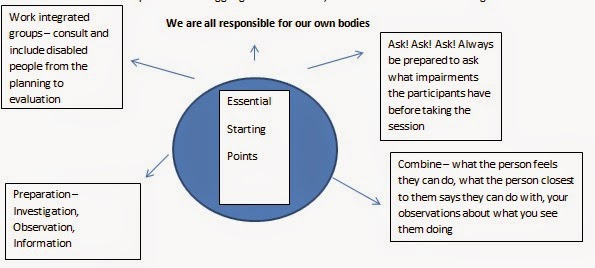Monday 7th April 2014
“In the studio, over
time, more and more I have lost that sense of division – disabled versus
non-disabled – though I couldn’t run my company, FOOT IN HAND, if I did not
acknowledge it in the world beyond. When I am teaching or making now though, 16
years into this stuff, for me, there are now only “a variety of people, their
ranges of movement and their different ways of understanding the world” And ,
for me, they are all valid and all potentially beautiful. I see my job as to
listen, to engage, actively make space to discover, to draw out; to connect one
dancer with another in a way that compliments both.” – Louise Katerega
This
evening Amy D, Amy O, Holly, Emma and James all took part in some Inclusive
Dance training with Louise Katerega. Our Inspire Dance Programme is ever
expanding and we are hoping to incorporate new journeys regarding inclusive
dance.
Louise spoke about the terminology regarding integrated dance (inclusive dance; dance by, for and with disabled people) and the correct terms of impairments, physical, learning or sensory. She stated how every body is able it is just the way in which we incorporate dance into our sessions is what can dis-able that person into struggling with movement, co-ordination and understanding.
Louise spoke about the terminology regarding integrated dance (inclusive dance; dance by, for and with disabled people) and the correct terms of impairments, physical, learning or sensory. She stated how every body is able it is just the way in which we incorporate dance into our sessions is what can dis-able that person into struggling with movement, co-ordination and understanding.
We began simple warm-up tasks that incorporated,
chair-users, leg-users/standing dancers, acknowledging how small simple
instructions using one body part and gradually building up to a phrase can be
shown and demonstrated to anyone, no matter their impairment.
We discussed about creating a neutral language between tutor
and participants and questioning
- · What is the basic essence or CORE PRINCIPLE of the movement/task you are giving / watching?
- · What body parts do we have in common? What kind of energy or feeling should the movement have?
For instance, STAND UP “everyone upright; find a place where
you are balanced; prepare to move”
WALK/RUN AROUND THE ROOM “travel around the room”
JUMP “send the energy
up; elevated”
TURN “rotate, change
direction”
Louise has worked in the inclusive dance field for over 16
years and through her many years of experience teaching a variety of dancers
and their impairments, had created herself a concise set of principles from
which to work by when working / planning for integrated dance sessions.
Teaching /
Creative Principles
- Remember to give yourself time in your sessions and take everything into consideration, whether that be changing, eating, or taking in information
- Preparation (giving yourself time to visit the class you are taking before, so you are aware of the participants who will be taking part)
- Aim for neutral language
- Understand and acknowledge the difference between movement which looks similar (aethsetic similarity) and instigates the same thing for the dancer (functional similarity)
- Connect energetically, through dynamics as well as shape
- For wheelchair users to offer a clear choice between using the spatial directions OR using the movement vocabulary
- Sometimes begin with directionality, for instance letting chair-users lead
- Connect through space, time and music
- Offer time and find ways for each individual to find increased degree if challenge for him/herself after setting an exercise
- Differentiate according to the body parts that are emphasised. Incorporate the skills needed and amount of previous experience, for instance the intensity of the movement or length of a taught phrase
- Understand and acknowledge who leads/initiates movement. It is a case of process and a change of principle. For instance allowing those who have minimal physical choices to start / lead a phrase and gradually build up to who has the most status in choreographic work.
Fun and creative games were implemented into the training in
order for us to try out simple and inventive tasks to assist with specific
issues that may occur during a session. For example, contact, timing,
choreography, energy building and improvisation
As
a group we were over-whelmed by how simple creative tasks, using the correct
terms and actively supporting, observing and participating can incorporate such
a wide range of disabled and non-disabled dancers. We were very grateful to
have such a talented and highly respected integrated dance artist, such as
Louise, visit us and broaden our knowledge of inclusive dance which we can now
integrate into our Inspire Dance Programme and over a wider range of dance
sessions.
Amy O'Sullivan - Community and Youth Dance Worker




No comments:
Post a Comment